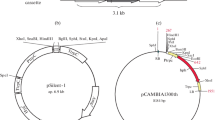Abstract
To study the effect of reduction in phytotoxin level on fungal chitinases, antagonistic Trichoderma spp. were screened for their ability to reduce the level of fusaric acid (FA), the phytotoxin produced by Fusarium spp. A T. harzianum isolate S17TH was able to tolerate high levels of FA (up to 500 ppm) but was unable to reduce the toxin to a significant level (non-toxic) added to minimal synthetic broth (MSB). However, the isolate was able to reduce 400 ppm FA in the liquid medium after 7 days to a non-toxic level and displayed similar level of antagonism over the control (without FA). In studies of the effect of the reduction in FA (400 ppm) level on chitinase gene expression in PCR assays, nag1 was significantly repressed but ech42 expression was only slightly repressed. Chitinase activity was either reduced or absent in the extracellular proteins of MSB supplemented with 400 ppm FA, which could be attributed to the effect of residual FA or its breakdown products through unknown mechanisms. Selection of S17TH as a toxin insensitive isolate that could commensurate the negative effect on chitinase activity makes it a potential antagonist against Fusarium spp.





Similar content being viewed by others
References
Fakhouri W, Walker F, Armbruster W, Buchenauer H (2003) Detoxification of fusaric acid by a nonpathogenic Colletotrichum sp. Physiol Mol Plant Pathol 63:263–269
Bacon CW, Hinton DM, Hinton AJr (2006) Growth-inhibiting effects of concentrations of fusaric acid on the growth of Bacillus mojavensis and other biocontrol Bacillus species. J Appl Microbiol 100:185–194
Lutz MP, Feichtinger G, Defago G, Duffy B (2003) Mycotoxigenic Fusarium and deoxynivalenol production repress chitinase gene expression in the biocontrol agent Trichoderma atroviride P1. Appl Environ Microbiol 69:3077–3084
Aggarwal R, Gupta S, Singh VB, Sharma S (2011) Microbial detoxification of pathotoxin produced by spot blotch pathogen Bipolaris sorokiniana infecting wheat. J Plant Biochem Biotechnol 20(1):66–73
Seidl V (2008) Chitinases of filamentous fungi: a large group of diverse proteins with multiple physiological functions. Fungal Biol Rev 22:36–42
Sharma V, Shanmugam V (2012) Purification and characterization of a 24 kDa chitobiosidase from the mycoparasitic fungus Trichoderma saturnisporum. J Basic Microbiol 52:324–331
El-Hasan A, Walker F, Buchenauer H (2008) Trichoderma harzianum and its metabolite 6-phenyl-alpha-pyrone suppress fusaric acid produced by Fusarium moniliforme. J Phytopathol 156:79–87
Shanmugam V, Sharma V, Ananthapadmanaban (2008) Genetic relatedness of Trichoderma isolates antagonistic against Fusarium oxysporum f.sp. dianthi inflicting carnation wilt. Folia Microbiol 53(2):130–138
Amalfitano C, Raffaele P, Anna A, Maurizio V, Maria CZ, Antonio E (2002) HPLC analysis of fusaric acid, 9,10-dehydrofusaric acid and their methyl esters, toxic metabolites from weed pathogenic Fusarium species. Phytochem Anal 13:277–282
Thakur M, Sharma DR, Sharma SK (2002) In vitro selection and regeneration of carnation (Dianthus caryophyllus L.) plants resistant to culture filtrate of Fusarium oxysporum f.sp. dianthi. Plant Cell Rep 20:825–828
Shanmugam V, Raguchander T, Balasubramanian P, Samiyappan R (2001) Inactivation of Rhizoctonia solani toxin by a putative α-glucosidase from coconut leaves for control of sheath blight disease in rice. World J Microbiol Biotechnol 17:545–552
Shanmugam V, Ronen M, Shalaby S, Larkov O, Rachamlm Y, Hadar R, Rose MS, Carmell S, Horwitz BA, Lev S (2010) The fungal pathogen Cochliobolus heterostrophus responds to maize phenolics: novel small molecule signals in a plant-fungal interaction. Cellular Microbiol 12(10):1421–1434
Singh NA, Shanmugam V (2012) Cloning and characterization of a bifunctional glycosyl hydrolase from an antagonistic Pseudomonas putida strain P3(4). J Basic Microbiol 52:340–349
Amusa NA (2006) Microbially produced phytotoxins and plant disease management. Afr J Biotechnol 5:405–414
Samiyappan R, Balasubramanian P, Babu S, Nandakumar R, Shanmugam V, Raguchander T, Ramanathan A (2002) Advances in molecular biology of phytotoxin production and its involvement in plant pathogenesis. In: Upadhyay RK (ed) Advances in microbial toxin research and its biotechnological exploitation. Kluwer Academic/Plenum Publishers, New York, pp 231–258
Mohamed ZA, Alamri SA (2012) Biodegradation of cylindrospermopsin toxin by microcystin-degrading bacteria isolated from cyanobacterial blooms. Toxicon. doi:10.1016/j.toxicon.2012.10.004
Romao-Dumaresq AS, de Araujo WL, Talbot NJ, Thornton CR (2012) RNA interference of endochitinases in the sugarcane endophyte Trichoderma virens 223 reduces its fitness as a biocontrol agent of pineapple disease. PLoS One 7:e47888
López-Mondéjar R, Catalano V, Kubicek CP, Seidl V (2009) The β-N-acetylglucosaminidases nag1 and nag2 are essential for growth of Trichoderma atroviride on chitin. FEBS J 276:5137–5148
Gruber S, Kubicek CP, Seidl-Seiboth V (2011) Differential regulation of orthologous chitinase genes in mycoparasitic Trichoderma species. Appl Environ Microbiol 77(20):7217–7226
Matarese F, Sarrocco S, Gruber S, Seidl-Seiboth V, Vannacci G (2012) Biocontrol of Fusarium head blight: interactions between Trichoderma and mycotoxigenic Fusarium. Microbiology 158:98–106
Acknowledgments
The authors are thankful to the Director, CSIR, Institute of Himalayan Bioresource Technology, Palampur for support and encouragement during the course of this investigation. The financial support received from the Council of Scientific and Industrial Research, New Delhi for awarding Senior Research Fellowship to Vivek Sharma is gratefully acknowledged. IHBT publication number: 1070.
Author information
Authors and Affiliations
Corresponding author
Rights and permissions
About this article
Cite this article
Sharma, V., Bhandari, P., Singh, B. et al. Chitinase Expression Due to Reduction in Fusaric Acid Level in an Antagonistic Trichoderma harzianum S17TH. Indian J Microbiol 53, 214–220 (2013). https://doi.org/10.1007/s12088-012-0335-2
Received:
Accepted:
Published:
Issue Date:
DOI: https://doi.org/10.1007/s12088-012-0335-2




